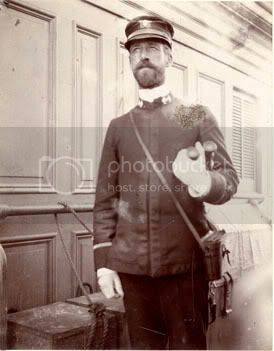Capt Charles E Vreeland

Acknoweledgement that certain information has been sourced for this article from Wikipedia
Charles E. Vreelland was born in Newark, New Jersey, on the 10th of March 1852.
He enlisted in the Navy as a naval apprentice early in 1866. After a brief service in the USS Sabine he was given a Presidential appointment soon afterwards to enter the U.S. Naval Academy on July 27th, 1866, graduating from that institution on June 7th, 1870 as a passed midshipman. He received his commission as an Ensign in November 1873 after a series of cruises onboard screw sloops.
Vreeland was further promoted to Master and then Lieutenant after successive tours of duty on board the screw steamer USS Alert, the gunboat USS Ashuelot and the sloop-of-war USS Ticonderoga. He was then assigned to the Nautical Almanac Office of the US Naval Observatory in November 1881 after a brief period ashore awaiting orders. In March 1884, Lt. Vreeland began a three-year tour at sea aboard the sloop-of-war USS Hartford, after which he was assigned for two years at the Bureau of Navigation. He was then assigned briefly from July to September 1889 with the Office of Naval Intelligence and reported to the Coast Survey late in October, a posting he took until the spring of 1893, when Vreeland was assigned a series of tours as naval attaché — first in Rome, Vienna and finally in Berlin.
After returning home in late 1896, Lt. Vreeland was posted to the battleship USS Massachusetts in mid-January 1897, and served aboard her until he was transferred to the gunboat USS Helena at the end of June, whereupon he served through most of the Spanish-American War on blockade duty off the port of Manzanillo until the end of July 1898, even though he was named executive officer of the cruiser USS Dolphin in April of that year. He did not actually assume those duties until August the 24th. He was detached from the Dolphin to serve aboard the USS Olympia on November the 6th that same year, but was ordered to the USS Concord instead on December the 30th due to a change in orders. Vreeland was promoted to Lieutenant Commander, and served aboard various vessels in the Asiatic Squadron. He returned home on board the hospital ship USS Solace in March 1900.
From April 1900 to August 1902 he was a member of the Board of Inspection and Survey, during which time he was promoted to full Commander in mid-August 1901. After his duty in the Board, he supervised the fitting out of the new monitor USS Arkansas (later renamed the Ozark) and assumed command upon her commissioning on the 28th of October of that year.
Two years later, Vreeland relinquished command of the Ozark and served on shore in a series of special assignments for the Department of the Navy for the next few years, during which he received his promotion to Captain on the 13th of April, 1906. After finishing his on-shore assignments in Washington, DC on the17th of April, 1907, Capt. Vreeland went to New York Ship in Camden, NJ the next day to commission the new Connecticut-class battleship USS Kansas. He commanded this mighty battleship for the next two years, which was an auspicious time, for the Kansas was picked to be part of the "Great White Fleet" that sailed around the world.
Soon after the Fleet returned to Hampton Roads on the 22nd of February, 1909 he gave up his command of the Kansas and returned home to await orders. On the10th of May, he succeeded Capt. Raymond P. Rodgers as Chief Intelligence Officer, the head of the Office of Naval Intelligence until December the 8th, when he was succeeded by Capt. Templin M. Potts.
As his promotion to Rear Admiral was imminent, he broke his flag in the USS Virginia as Commander, 4th Division, Atlantic Fleet. On December 27, and he became Rear Admiral Charles Vreeland.
On the 19th of April, 1911 he reported ashore for further duty in Washington as part of newly devised aide system for managing the Navy, Vreeland became one of the four principal advisors to the Secretary of the Navy, George von Lengerke Meyer. As Aide for Inspections, he reached the pinnacle of naval command. During his tenure, he represented the Navy at the coronation of George V of the United Kingdom, as well as heading the so-called "Vreeland Board" which reinvestigated the sinking of the USS Maine in 1898, the controversial report of which — now widely regarded as erroneous — concluded that an external explosion sank the Maine.
On the 12th of December, Rear Admiral Vreeland ended his tour of duty as Aide for Inspections and succeeded Rear Adm. Richard Wainwright as the second Aide for Operations. While in that position, Vreeland struggled to improve the defenses in the Philippine Islands, agitated for increased naval construction, particularly of battle cruisers, and supported the development of US naval aviation. It was also during his tenure that naval aviation found a permanent home in Pensacola, FL. On February the 11th, 1903 he was succeeded by Bradley A. Fiske as Aide for Operations, and Vreeland finished out his naval career as member of both the General and Joint Boards. He retired on the 10th of March, 1914.
Rear Admiral Charles E. Vreeland died in Atlantic City, New Jersey after a brief retirement marked by illness.
The Knox-class frigate USS Vreeland (FF-1068) was named after him.
The next instalment will be another interesting fact from the cruise of The Great White Fleet.
Regards
Sean









